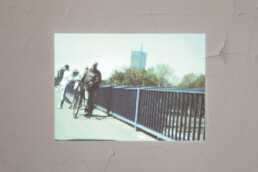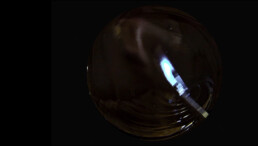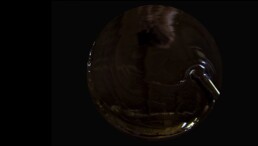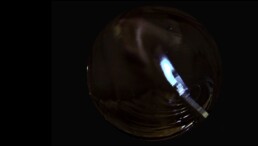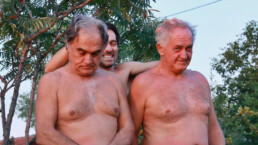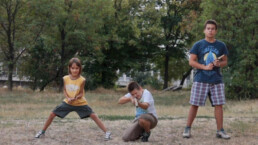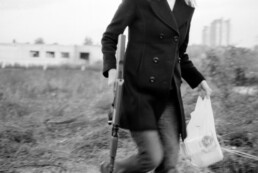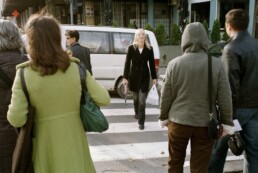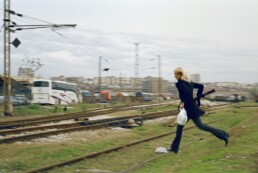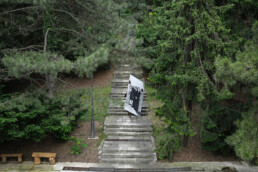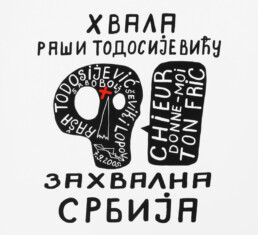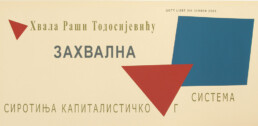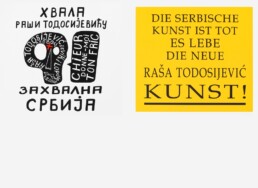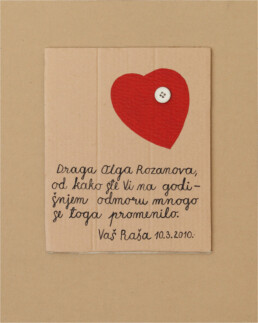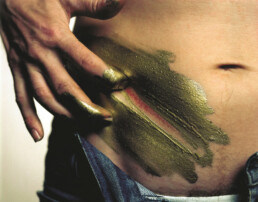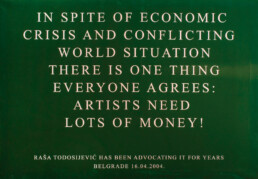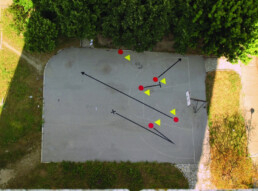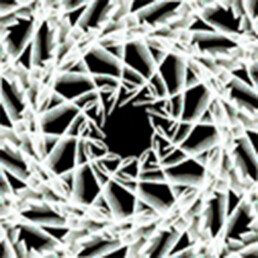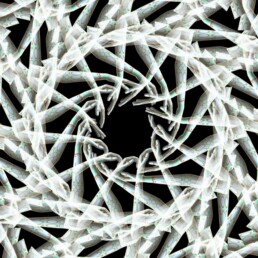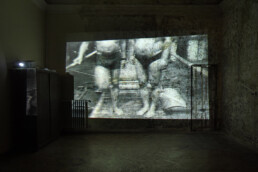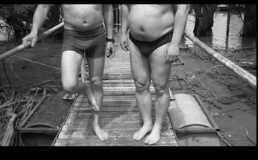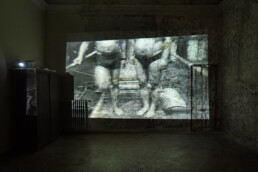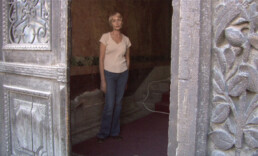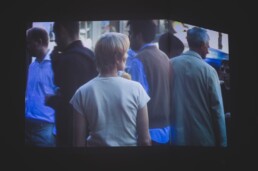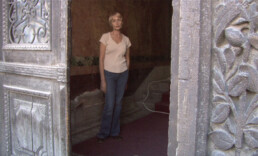XYZ
XYZ
Re-Passage
video
7’56”
2012
Re-Passage
video
7’56”
2012
Re-Passage is a video performance whose final result is achieved by computer editing. We pushed a bicycle backwards from point B to point A and filmed the action. It was a story about connecting Branko’s Bridge and the Geodetic Institute; encounters with pedestrians, interactions and micro-stories. There was also the absurd idea that, by repeating a procedure, one can go back in time…). Pushing a bike and walking backwards is a confusing, psycho-mechanically uncomfortable action, and maybe similar to the feeling of having to move in a wheelchair.
From the catalogue of the 53rd October Salon
The video works Quartz, Hats and Re-Passage were exhibited at the 53rd October Salon, as some of numerous site-specific works realized in Belgrade and/or the building of the former Geozavod in Savamala.
© Cultural Centre of Belgrade, the October Salon Collection and the artists
Gift Contract:
Inventory No. 215
Photo: still from the video work
Selected Bibliography:
53rd October Salon, Good Life: Physical Narratives and Spatial Imaginations. Cultural Centre of Belgrade, 2012
ABOUT THE AUTHORS:
The XYZ Group consists of two visual artists – Milan Tittel (1966, Bratislava, Czechoslovakia), graduated from the Academy of Applied Arts and Design (Sculpture Department) in Bratislava, and Matej Gavula (1972, Litomyšl, Czechoslovakia), graduated from the Academy of Applied Arts and Design (Glass Department) in Bratislava. They live and work in Bratislava, Slovakia. The XYZ Group was formed in 1997, and its name takes on the meaning of the last three letters of the alphabet. They are focused on contextual research in the medium of sculpture. Their work is described as oscillating between stability and instability, between monuments and miniatures, in maintaining resonances between moments captured on digital records and the objective presence of plastic materials. Since 1998, as an art duo, they have presented their work at numerous festivals and solo and group exhibitions throughout Slovakia and Europe. They participated in the 53rd October Salon in 2012.
Anica Vučetić
ANICA VUČETIĆ (1962)
Nothingness
single-channel video installation
HD projection on round surface
1’45” in a loop, without sound
edition 1/5
2013
Nothingness
single-channel video installation
HD projection on round surface
1’45” in a loop, without sound
edition 1/5
2013
The video installation Nothingness is a specific video environment, where – in a dark space – the viewer encounters a stirring, dark surface that, in a slow, circular motion, acts as if drawing them into its mass. The circular and hot surface of tar, which reflects the surrounding space like a mirror, filmed from up close and projected in slow motion, almost covers with its reflection the heavy, sticky, hot, dense substance beneath the surface.
The work Nothingness, and the whole art practice of Anica Vučetić, exposes various inner processes of the artist, displaced from the reality in which they were produced. The allegorical content of this work has roots in the artist’s involvement with Jungian psychology, although in fact it carries deeply personal meanings. For Anica Vučetić, the exhibition space is often the measure, delimitation and metaphor for mental procedures, as dreams, memories and desires. Nothingness looks like a swirl of some liquid, darker and thicker than water. It is projected in a loop onto a round surface that the visitor faces in a fully darkened space. It spins slowly, in a hypnotizing way, and, since its dimensions are larger than human, it produces the effect of drawing the viewer into an alternate reality. There is no illusionism – that alternate reality cannot be seized by the gaze, but only invoked in the memory of the viewer. The installation presents a visualization of the dark chaotic psychic state, which used to be called nigredo by alchemists, and has its parallel in mystical literature as the dark night of the soul, and in mythology, in the descent into the underworld.
© Cultural Centre of Belgrade, October Salon Collection and the artist
Purchase Contract: III-5-378/16.11.2016.
Inventory No. 1455
Photo: still from the video installation
Selected Bibliography:
Anica Vučetić: The Fall, Sept. 6 – Oct. 20, 2013, text by Stevan Vuković, catalogue of the solo exhibition, Salon of the Museum of Contemporary Art Belgrade, 2013
ABOUT THE AUTHOR:
Anica Vučetić (1962, Belgrade, Serbia) graduated in painting (1986) and won her master’s degree (1989) from the Faculty of Fine Arts in Belgrade. A freelance artist since 1989. She does video installations and video environments. Her works have been presented at more than thirty solo exhibitions in Belgrade, Sarajevo, Čačak, Vršac, Novi Sad, Požega, at the Museum of Contemporary Art of the University of Sao Paulo, Museum Ludwig Forum for International Art in Aachen, Cuban Institute of Arts and Film Industry in Havana, Museum of Republika Srpska in Banja Luka, Rotovž Salon in u Maribor, in Raška, Sopot, at Perjanički dom in Podgorica… as well as at numerous group exhibitions and international events in the country and abroad (Bosnia and Herzegovina, Slovenia, Croatia, Montenegro, France, Germany, Spain, the Netherlands, Belgium, USA, Russia, Italy, Portugal, Great Britain, the Czech Republic, Macedonia, Greece, Japan, Canada, Sweden, Denmark, etc.). She has received major awards in the field of contemporary visual art: the 23rd Nadežda Petrović Memorial Award and the Audience Award at the 23rd Nadežda Petrović Memorial in Čačak (2005), the Grand Prix at the 9th Gornji Milanovac International Biennial of Arts and the Politika Prize from the Vladislav Ribnikar Fund in Belgrade (2008).
Miloš Tomić
MILOŠ TOMIĆ (1976)
A Cousinly Slap
film
15’
2012
A Cousinly Slap
film
15’
2012
The work was exhibited at and produced for the 53rd October Salon, Good Life.
The film is the artist’s personal story about an attempt to restore the long-lost or cooled connections with relatives he remembers from his childhood.
In the style of those trips down the family tree, I travel, get in touch with people I remember well from my childhood and ask them for advice on how to finally make that “real film”. Of course, as the title of the film says, we would sometimes get in a fight for this film. A friendly – cousinly fight. More of a slap fest, a wrestling match… Although many of them are past their prime, as opposed to back then, when I was a kid and my insolence was the cause of many, many slaps. Today, after all the thrashing, I usually sincerely hug them when we get together; I am hot, sweaty and strangely – happy. After all, those things are good and very healthy for me, since I am rather cowardly when it comes to fights and brawls. I remember a remark from a soldier, when I was in the army and after I had finally gotten into a fight with my eyes closed, probably not breathing: “Look at that, he got beaten up and it’s fine by him!”
Miloš Tomić, from the catalogue of the 53rd October Salon
© Cultural Centre of Belgrade, the October Salon Collection and the artist
Gift Contract: III-5-131/1.6.2020.
Inventory No. 210
Photo: still from the film
Selected Bibliography:
53rd October Salon, Good Life: Physical Narratives and Spatial Imaginations. Cultural Centre of Belgrade, 2012
ABOUT THE AUTHOR:
Miloš Tomić (1976, Belgrade, Serbia) graduated in film directing from the Faculty of Dramatic Arts in 2001, under Professor Miša Radivojević. He received his master’s degree from the FAMU Film Academy in Prague in 2006, Department of Multimedia Animation, in the class of Professor Petar Skala, and in 2013 received a doctorate from FAMU with the thesis “Preciousness of discarded objects – trash, as the material for film, animation, photography…” He is a co-founder of the legendary group Klipani u pudingu [Bumpkins in Pudding], a passionate collector and patient collagist, an active participant and propagandist of the LO-Fi Festival, who fought for free, cheap and independent films during the 1990s; for the past several years he has been a professor at the Faculty of Media and Communications in Belgrade, Department of Digital Art and New Media. As an author, he has participated in numerous exhibitions throughout the region and Europe. His art career gained new momentum in 2013, when, together with Vladimir Perić, he represented Serbia at the Venice Biennale. Lives and works in Belgrade.
Milica Tomić
MILICA TOMIĆ (1960)
One Day instead of One Night a Burst of Machine-Gun Fire Will Flash, if Light Cannot Come Otherwise (from the poem One Day by Oskar Davičo)
action/intervention in public space, performed in Belgrade
10’
edition: 1/5 + 1 a.c.
2009
Purloined Letter (Edgar Alan Poe)
lambda print, photo: Armin Linke
180 cm x 120 cm
edition: 1/5
2014/2015
One Day instead of One Night a Burst of Machine-Gun Fire Will Flash, if Light Cannot Come Otherwise (from the poem One Day by Oskar Davičo)
video of the action/intervention in public space, performed in Belgrade
10’
edition: 1/5 + 1 a.c.
2009
Every day, for two months, in the autumn of 2009, I walked to the places where successful anti-fascist actions were carried out by citizens and members of the People’s Liberation Movement in Belgrade during the German occupation in the Second World War. Photo and video footage of these repeated walks are a document of building a non-material monument, dedicated to events that are not part of public memory. With this action, first of all, I want to open the question of anti-fascism today and its erasure from public history and public memory, as well as its relevance in relation to new circumstances and new forms of fascism. Today, it is easy to recognize fascism in its excess forms, but the question is what about fascism that is all around us, that cannot be easily recognized at first sight, because it is built into laws and administration, and thus into our everyday life.
Milica Tomić
Dedicated to the Anarcho-trade unionists of Belgrade, Sept. 3, 2009
Audio recording: interviews with members of the People’s Liberation Movement in Belgrade Šime Kronja, Jelena Kadenić, Radošin Rajević, Dimitrije Bajalica
Camera and Sound: Staša Tomić
Editor: Miloš Stojanović
Sound Designer: Vladimir Janković Slonče
© Cultural Centre of Belgrade, October Salon Collection and the artist
Gift Contract: III-5-295/29.9.2014.
Inventory No. 1369
Photo: still from the video work, courtesy the artist, Srđan Veljović
Purloined Letter (Edgar Alan Poe)
lambda print, photo: Armin Linke
180 cm x 120 cm
edition: 1/5
2014/2015
The photograph was taken when she was researching in the archive of the President’s Photo Service (1947–1980, Josip Broz Tito) and preparing a work for the exhibition Travelling Communiqué at the Museum of Yugoslav History in Belgrade. Entering the archive and accessing this valuable material raised the issue of the relationship between the time when the photograph was made and us, artists who now have the right to exhibit this material and, decomposing it into fragments, change the significance of the original intention of the authors. The work Purloined Letter examines the fragmentation of great political narratives, raises the question of delayed audience and introduces Jacques Lacan’s comment that a letter always arrives at its destination and reaches its addressee, regardless of the original intention of the sender.
Milica Tomić
© Cultural Centre of Belgrade, October Salon Collection and the artist
Purchase Contract: III-5-477/1/19.12.2019.
Inventory No. 1669
Photo: Courtesy the artist
ABOUT THE AUTHOR:
Milica Tomić (1960, Belgrade, Yugoslavia). She is a conceptual artist who explores different fields, genres and methods of contemporary art practice. Her work focuses on researching and asking questions about political and economic violence, trauma and social amnesia, which she places in the sphere of public debate, with special attention to the ‘short circuit’ of the relationship between intimacy and politics. In response to the social changes and new forms of ‘collectivity’, which are at the core of Milica Tomić’s work, she made a marked shift from individual to collective artistic practice. She is a co-founder and members of the Monument Group, a New Yugoslav art theory group (2002), and a co-founder of the Working Group – Four Faces of Omarska (2010). Tomić has participated in many international exhibitions, including the 24th Sao Paulo Biennale (1998); 49th Venice Biennale (2001); 50th Venice Biennale (2003); 8th International Istanbul Biennial (2003); Populism, National Museum of Art, Oslo/Stedelijk Museum, Amsterdam / Frankfurter Kunstverein (2005); 15th Sydney Biennale (2006); Manufacturing Today / Trondheim Biennale (2010); 10th Sharjah Biennial (2011); Odessa Biennial (2013); Monuments Should Not be Trusted, Nottingham Contemporary, Nottingham, England (2016); Red Africa at Calvert 22, London / Galeria Avenida da Índia, Lisbon, Portugal (2016/17); Body Luggage, Kunsthaus Graz (2017); Sequences. Art of Yugoslavia and Serbia, Museum of Contemporary Art, Belgrade (2017); Volksfronten/Exhibiting at the Trowel’s Edge/Steirischer Herbst, Graz, Austria (2018), etc.
She participated in the 45th, 49th, 52nd and 54th October Salons.
More information at https://milicatomic.wordpress.com
Dragoljub Raša Todosijević
DRAGOLjUB RAŠA TODOSIJEVIĆ (1945)
Thank You Raša Todosijević, the Grateful Poor of the Capitalist System
lithograph
70 cm x 101 cm
2005
Serbian Art Is Dead, Long Live the Art of Rasa Todosijević
screen print
83 cm x 70 cm, diptych
2006
Dear Olga Rozanova
acrylic on cardboard
30 cm x 25 cm
2010
Art, Sex and History
digital print
85 cm x 67 cm, triptych
2012
Despite the Economic Crisis…
print on canvas
97 cm x 140 cm
2004
Thank You Raša Todosijević, the Grateful Poor of the Capitalist System
lithograph
70 cm x 101 cm
2005
Serbian Art Is Dead, Long Live the Art of Rasa Todosijević
screen print
83 cm x 70 cm, diptych
2006
Dear Olga Rozanova
acrylic on cardboard
30 cm x 25 cm
2010
© Cultural Centre of Belgrade, the October Salon Collection and the artist
Gift Contract: III-5-293/29.9.2014.
Inventory No. 1362, 1363, 1364
Photo: Milan Kralj
Art, Sex and History
digital print
85 cm x 67 cm, triptych
2012
© Cultural Centre of Belgrade, the October Salon Collection and the artist
Purchase Contract: III-5-481/1/15.12.2014.
Inventory No. 060
Photo: Milan Kralj
Despite the Economic Crisis…
print on canvas
97 cm x 140 cm
2004
© Cultural Centre of Belgrade, the October Salon Collection and the artist
Gift Contract: III-5-11/15.1.2016.
Inventory No. 077
Photo: Milan Kralj
What singles out Raša Todosijević from other participants of the informal Belgrade group of artists, the fellow-artists from Vojvodina and the next generations of Belgrade conceptual artists is a persistent, uncompromising and radical political discourse that he has never abandoned. This makes Todosijević a unique figure in contemporary Serbian art; he is an example of a politically emancipated man and a socially responsible artist who has produced few works that wouldn’t involve a critical intervention of some sort. As he himself has put it, “in ethical, political and social clashes, art sharpens and underlines the meaning.” And the meaning of Todosijević’s message in general should be sought in the commitment to radical politicization of art, by which we mean the programmatic re-examination of the systemic conventions of art and their ideological apparatuses, and the activation of the position of art within the social practice. The functional dimension of Todosijević’s work in a way resembles that of Hans Haacke, who once said: “Part of my message is that art should have a use value rather than be seen as the commodity produced by an entrepreneur.”
Dejan Sretenović, catalogue of the solo exhibition Thank You Raša Todosijević, held at the Museum of Contemporary Art Belgrade
He has exhibited at the 45th, 47th and 50th October Salon. Within the KCB edition “Sam (a) svoj pokret”, a collection of stories by Raša Todosijević was published and translated into Italian language as a part of the “Voyage to Europe” Project.
Selected Bibliography:
Thank You Raša Todosijević, text by Dejan Sretenović, catalogue of the solo exhibition, Museum of Contemporary Art Belgrade, 2002
ABOUT THE AUTHOR:
A brief and embellish version of my miserable life in Belgrade
I was born on September 2, 1945, in Belgrade, on Narodnog Fronta Street; before the Second World War the street was called Kraljice Natalije Street. First we – my honorable parents and I – lived on Rumunska Street, up in Dedinje (later called Užička Street). Then, for some reason or other, we moved to 17 Šajkaška Street. That’s down by the Dunav train station. When the city authorities inexplicably tore down that beautiful building in the French style, we moved to 115 Cvijićeva Street near the Novo Groblje Cemetery. Some ten or so years later, we moved to the suburbs, out in the sticks, to 21 Jablanička Street. Much later I finally got an apartment of my own, a tiny space of freedom in the neighborhood of Senjak, more specifically on Prahovska Street that used to be called Američko Sokače. When Marinela’s parents left this world, I settled down in the center of town on General Ždanova Street, which was given back its old prewar name of Resavaka Street several years ago.
First my half-deaf maternal aunt Stojanka tried with might and main to get me to learn the upholsterer’s trade and become an upholsterer like her brother, my uncle Pedi. Then I tried to be an army pilot in Mostar. Since I wasn’t very good at this either and I didn’t like the boring cadet crowd, I went back to Belgrade. I took a two-year drawing and sculpting course at 122a Šumatovačka Street. Finally, in 1964, one year after the earthquake in Skopje, I enrolled at the Academy of Fine Arts in Belgrade. My teachers at the Academy had embarrassingly little talent and even less education; a lethal mixture of mediocrity, bootlickers and conceited phantoms. I had no other choice but to travel around the world and educate myself as best I could, so that using my meager forces, I succeeded in shaking off the invisible yoke of wide-ranging provincialism. I was given an atelier exactly thirty years later at the so-called Staro Sajmište that was a German concentration camp during the Second World War. Sometimes as I listen to quiet music in the atelier, it seems to me that the sorrowful souls of the slain inmates come to visit and politely say hello.
Belgrade, 2009
Dragoljub Raša Todosijević (1945, Belgrade, Serbia). He graduated from the Academy of Fine Arts in Belgrade in 1969. He has been a member of ULUS since 1971. He has exhibited independently and within group exhibitions around the world. His works are in the collections of the Museum of Contemporary Art in Belgrade, the Museum of Contemporary Art in Zagreb, the Modern Gallery in Ljubljana, the Moderna Museet in Stockholm, the Archivio Francesco Konz in Verona, The Roland Gibson Collection, Gallery of Ingrid Dacić, the Široki Brijeg Collection, private collections of Vladimir Macura, Igor Čuček, Hubert Kloker and Slavko Timotijević. He lives and works in Belgrade.
Zоrаn Тоdоrоvić
ZORAN TODOROVIĆ (1965)
Correction/Portrait|
photo collage
220 cm x 90 cm
2004
The Bride #3
photo collage
280 cm x 100 cm
1998
Correction/Portrait|
photo collage
220 cm x 90 cm
2004
Correction/Portrait is the photo documentation before, during and after an aesthetic correction on the face of the artist and the then director of the Museum of Contemporary Art of Vojvodina Živko Grozdanić. The surgically performed correction of the portrait was made according to sketches and the idea of Zoran Todorović.
At the 50th October Salon, Circumstance, he exhibited the work Gypsies and Dogs, a two-channel video installation.
One of the most common procedures in cosmetic surgery is the correction of the auricle – lop earedness, and the aim of this “action” was to bring Grozdanić’s face closer to a model considered desirable and classically beautiful. An important characteristic of this work, present throughout Todorović’s practice, is the potential of a staged and performed situation/action/event which becomes a work of art. Todorović deliberately uses certain forms of production aimed at transforming human material/body (fat, tissue, hair, skin) into an artefact or item of commodity (soap, blanket, clothing).
If the body is a field of diverse cultural content, as well as a cultural construction dependent on the model of sexuality, racial and class recognition, a diet, physical activity and way of dressing, in this case, it is a process of deletion of the already existing entries. What happens to Grozdanić is what happens regularly to those involved in the mechanisms of cultural industry, from folk/pop musicians to actors and athletes, as well as to social and political figures, who engage the affective attention of the masses and who therefore serve as identification models: he is being “redesigned” according to the taste of the masses and the desired result of that imagined identification process. Todorović, on the other hand, with this act leaves the sphere of sole personal responsibility, determined by actions over his own body, in which his work was imprisoned before, and enters the field of manipulation with another person’s body.
© Cultural Centre of Belgrade, the October Salon Collection and the artist
Purchase Contract: III-5-482/1/15.12.2014.
Inventory No. 1395
Photo: Courtesy of the artist
The Bride #3
photo collage
280 cm x 100 cm
1998
The work Bride #3 is a performance in which the artist uses a naked female body, coated with sugar solution, covered with kilos of flies grown for the occasion and a “veil” of semi-translucent fabric, as an object (object of observation) which is at the same time the subject (participant/performer) in the performance. Todorović stages The Bride as a live performance, although the performing/performance is presented through the documentation of the event. In that sense, the performance event takes place in “privacy” and, through photo collages, appears in “public”, involving the interaction with the viewers, who often have an aversion to exposed intimacy.
It was performed by Tanja Ostojić, an artist who began her art practice in Yugoslavia in 1996 as a performer in the adverse circumstances of an isolated art scene. The documentation on the events/works by Zoran Todorović is just an art form, and the initiated events are those moments in which art, regardless of the given parameters, opens the possibility of performing a form of life. Todorović also stages The Bride as a “live performance” that introduces new media or social technologies to a specific performance situation – the relationship between private and public – intimate and shared.
© Cultural Centre of Belgrade, the October Salon Collection and the artist
Gift Contract: III-5-329/24.08.2018.
Inventory No. 113
Photo: Courtesy of the artist
Selected Bibliography:
INTENZITET AFEKTA: Performansi, akcije, instalacije: retrospektiva Zorana Todorovića, Mar. 18 – Apr. 6, 2009, Museum of Contemporary Art of Vojvodina, Novi Sad, 2009
Jasmina Čubrilo, About Restoring and Nourishing/Eating Beauty, Reč 49, Belgrade, 1998
Stevan Vuković, “Korekcija/Portret”, Exhibition Catalogue Konkordija Gallery: Exhibition Practice as a Cultural-Political Strategy, May-August 2004, Museum of Contemporary Art, Belgrade, 2004
Zoran Todorović: Warmth, 6.06 – 22.11.2009, Pavilion of Serbia at the 53rd Venice Biennale, Museum of Contemporary Art, Belgrade, 2009
ABOUT THE AUTHOR:
Zoran Todorović (1965, Belgrade, Serbia) is a professor at the Faculty of Fine Arts, University of Arts in Belgrade; one of the initiator of the Transmedia Research Course. In his work, he thematizes the issues of surveillance, bio-political management and control – revealing unpleasant truths and hidden motivations. Since 1992 he has presented his works at leading local and international institutions and festivals of new media in Europe and the world. He represented Serbia at the 53rd Venice Biennale. His works are part of private and public collections in the world and in Serbia. The winner of the October Salon Award in 2000.
Predrag Terzić
PREDRAG TERZIĆ (1972)
Duško Vujošević releasing a player for a shot
Joey Dorsey (Olympiacos – FC Barcelona Regal 68–64)
Elan Vital Series
photograph
74 cm x 90 cm (2 pcs)
2011–2014
Duško Vujošević releasing a player for a shot
Joey Dorsey (Olympiacos – FC Barcelona Regal 68–64)
Elan Vital Series
photograph
74 cm x 90 cm (2 pcs)
2011–2014
The Elan Vital cycle of photographs is a series of visually solved basketball attacks on the courts in Belgrade, Zaječar, Čačak, Kraljevo, Požega, Herceg Novi (Montenegro), Trebinje (Republic of Srpska, Bosnia and Herzegovina), Wroclaw (Poland), Milan (Italy) and Madrid (Spain). In these interventions, each attack or action bears the name of the basketball legend who performed it, or of the place where the action was reconstructed or re-performed (LeBron James (Cavaliers vs Orlando game 2), NBG 2009, Jasikevicius (PAO vs CSKA 73 71), Duško Vujošević releasing a player for a shot, Joey Dorsey (Olympiacos – FC Barcelona Regal 68–64), Paths of Glory, Nemanja Bjelica (FC Barcelona – Fenerbahce Ulker)). This kind of intervention in space indicates the ways of shaping and presenting theoretical frameworks in basketball that a coach conveys to the players. The players transfer the coach’s ideas to the field, and Terzić transfers these ideas by means of graphic elements in order to visualize them. Through signs and symbols, the artist re-creates a certain moment that can be performed over and over again. In this sense, the graphic elements used to illustrate the sports action become a draft for choreography and space for re-performance.
In Predrag Terzić’ opus, there are three cycles that refer to basketball.
The first cycle National Service (started in 2005/2006), consists of portraits of players and coaches who brought changes in the concept of the game under the hoops. The development of the concept is shown in the second cycle, Elan Vital, where Terzić leaves figurative drawing and figurative presentation in general and enters the field of abstraction and performative action over which he has no control, except in setting up a “basis” that would serve as instructions for performing sports “choreography”/ action. The third cycle, Leistung (On Lightness and Weight), in a way rounds off the relationship between sport and art shown in the previous two cycles and focuses on the touch and the way of presenting the interactions of bodies in space through drawing and/or wall drawing. With his works, Terzić tries to encourage dialogue and examine the meaning of sport and its transposition into the public sphere of art.
© Cultural Centre of Belgrade, the October Salon Collection and the artist
Purchase Contract: III-5-377/16.11.2016.
Inventory No. 1458
Photograph: Courtesy the artist
Selected Bibliography:
55th October Salon, Disappearing Things. Cultural Centre of Belgrade, 2014
Predrag Terzić: Elan Vital, Apr. 19 – May 13, 2013, Contemporary Art Gallery Smederevo, catalogue for the solo exhibition, Smederevo, 2013
Predrag Terzić: ŽIVOTNI POLET//ELAN VITAL, Nov. 1–13, 2011, Youth Centre Gallery, Beograd, text for the exhibition by Anja Obradović, 2011
ABOUT THE AUTHOR:
Predrag Terzić (1972, Belgrade, Serbia) graduated (in 2000) and received his master’s degree from the Faculty of Fine Arts in Belgrade, under Professor Čedomir Vasić. He received a PhD degree from the University of Arts in Belgrade – Interdisciplinary Studies. He has exhibited in the country and abroad; currently works as a professor at the Faculty of Media and Communications. His works are part of numerous public and private collections in the country and abroad. More information at www.predragterzic.com
Nataša Teofilović
NATAŠA TEOFILOVIĆ (1968)
a|symmetry
3D and 2D animation of humanoids
7’57”
2013
a|symmetry
3D and 2D animation of humanoids
7’57”
2013
The a|symmetry animation developed from a single movement of a virtual arm that sensually and inquisitively touches the void of virtual space. After multiple multiplication, this isolated movement is no longer recognized as a single element but forms one picture. Rotation, symmetry and gradual delay of the movement generate an abstract form that associates with the organic structure and assumes the qualities of symbols like mandala or some kind of revived pulsating universe. By multiplying, every slightest twitch of the finger gets a dramatic impulse and velocity in the final composite form.
This kind of generating the picture in a|symmetry was chosen with the intention to metaphorically present the idea of creating a system of meaning. Each individual and isolated situation, after multiple observations, refractions – “mirroring” like a kaleidoscope, forms a centric and stable picture. The resulting “big picture”, created by an individual unpretentious humanoid movement, points to the message of unity, tenderness, love, human sensuality and imperfection (a-symmetry) that make us unique. In her procedure, the work process itself plays a significant role, and the end result depends on it, as well as on the management and manipulation of individual segments of that process. Interdisciplinary research of this artist requires knowledge in various fields of art, science and technology, such as painting, sculpture, graphic design, film language, anatomy, psychology, the laws of physics, programming, command of software, etc.
© Cultural Centre of Belgrade, October Salon Collection and the artist
Purchase Contract: III-5-376/16.11.2016.
Inventory No. 1453
Photo: still from the video work
Selected Bibliography:
Nataša Teofilović: Distance [1995–2016], 6 – 22. 05. 2016, Exhibition Catalogue, Museum of Contemporary Art of Vojvodina, Novi Sad, 2015
Nataša Teofilović, Umetnost pokreta u prostoru praznine (tehnologija i praksa virtuelnih karaktera), Faculty of Architecture, Belgrade University, Belgrade, 2011
Sanja Kojić Mladenov, Skok i zaron: diskursi o rodu u umetnosti: konstrukcija profesionalnog identiteta umetnica u oblasti novih medija u Vojvodini krajem 20. i početkom 21. veka, Belgrade, 2020
ABOUT THE AUTHOR:
Nataša Teofilović (1968, Pančevo, Serbia) is an artist who explores manifestation and identity of the female and the sensual in the virtual space through new media and computer art. Her work has ranged from neo-conceptual art in the early 90s to digital art of the new century, which combines art, science and technology. As for her technique, she works in various media – from experimental video and performance to 3D character animation and digital ambiances. Her digital works can be described as interdisciplinary, hybrid and interactive art. She has contributed to education in and understanding of digital art, especially 3D animation, with her doctoral work, the first doctoral thesis in Serbia in the field of digital animation. She has had numerous solo exhibitions and participated in many group ones, in the country and abroad, of which the following stand out: Ars Electronica (Austria, 2007), Incheon International Digital Art Festival 2009 (Korea, 2009), DAT – Digital Art & Technology (Singapore, 2007), KIBLIX 2014 – Parallels (Slovenia, 2014), Premonition, Blood, Hope – Art in Vojvodina and Serbia from 1914 to 2014 (Austria, 2014), Cargo East, The Subdued Existence: Serbian Contemporary Art Scene (Taiwan, 2014; B&H; Slovakia, 2015). More information at https://vimeo.com/user5395533
Berit Talpsepp
BERIT TALPSEPP (1982)
Šest topola (Six Poplars)
video
3’23”
2012
Šest topola (Six Poplars)
video
3’23”
2012
Berit Talpsepp’s installation Šest topola is a result of the research for the production of her work for the 53rd October Salon: Good Life in 2012. The starting point was three photographs she came across in a Belgrade flea market. These were photos of two men walking on a beach, posing for the camera, trying to look attractive and sporty. On the back of each photograph, there was an inscription containing the year 1936, and two words: “Šest topola”. By recreating the leisure atmosphere from the photographs, the artist decided to bring back the seen moment from the past – good life – and project it on the present.
Determined to explore what the words on the back of each photograph mean, Berit Talpsepp found out that “Šest topola” was the name of an old restaurant situated on the banks of the Sava River, close to a group of six poplar trees. The artist went there to look for the restaurant and found out that the scene captured in those photographs had changed entirely — the smiling, tanned, carefree people were gone from the sunny boulevard, and only one poplar tree still remained. The poplars may have been cut down, and the two men may have been dead for some time, but that moment on the beach in 1936 was captured and preserved in the photographs. She decided to bring these embalmed moments back to life, to re-create in the present the unusual sense of a good life seen in the photographs. “Like the old photographs found in the flea market, my work captures a good life, snatching it from the flow of time; to be discovered and re-created.”
Berit Talpsepp, text in the catalogue of the 53rd October Salon
© Cultural Centre of Belgrade, October Salon Collection and the artist
Gift Contract:
Inventory No. 209
Photo: still from the video work
Selected Bibliography:
53rd October Salon, Good Life: Physical Narratives and Spatial Imaginations. Cultural Centre of Belgrade, 2012
ABOUT THE AUTHOR:
Berit Talpsepp (1982, Tartu, Estonia) is an artist who lives and works in Finland. She studied at the Estonian Academy of Arts and Glasgow School of Art. Berit’s research interests have been cultural and individual memory in conjunction with time, death and personal memories. Her practice is mostly in sculpture, video and photography. She has presented her works at solo and group exhibitions at many important institutions throughout Europe, including the Kunstguss Museum, Germany; Gallery Noorus, Tartu, Estonia; Museum of Contemporary Art in Helsinki, Finland; Monteaudio 13, International Sound Festival, Montevideo, Uruguay; etc. She participated in the 53rd October Salon Good Life, Physical Narratives and Spatial Imaginations in Belgrade in 2012. More information at http://www.jaanisoo.com/berit/
Annika Ström
ANNIKA STRÖM (1964)
A Woman Standing Inside an Old Building / A Women Standing Outside an Old Building
video-documentation of the performance realized at the opening of the 53rd October Salon
6’54”
2012
A Woman Standing Inside an Old Building / A Women Standing Outside an Old Building
video-documentation of the performance realized at the opening of the 53rd October Salon
6’54”
2012
Annika Ström made her first performance in 1995 with her mother Anna Ström in a Berlin gallery. Since then, she has given a lot of performances – being a singer, composer, synthesizer player. Later she started hiring other performers to act simple scenes or emotions instead of her; for example, at the Frieze Art Fair in London, when ten men were walking around looking embarrassed.
During her stay in Belgrade, where she came at the invitation of the curators of the 53rd October Salon, Branislav Dimitrijević and Mika Hannula, her main research area was the former Geozavod Building in Savamala (where the exhibition was held).
This old building, which kept so much history of the city, became the main subject of the performance made at the opening of the 53rd October Salon. During the performance, a woman (Marija Opsenica, actress and performer) was standing motionless, without any interaction with the people going in and out, first at the entrance of the old building, then outside it. Numerous visitors who came to the opening were passing by the woman, often not noticing her. The work is actually about our attitude towards history, about how we forget or are forced to forget. It appeared as if the woman, like the old building, was keeping a secret and history in herself.
At the 53rd October Salon, Annika Ström also presented two films and an inscription on the wall.
© Cultural Centre of Belgrade, October Salon Collection and the artist
Gift Contract: III-5-337/04.9.2018.
Inventory No. 1671
Photo: still from the video recording of the performance, courtesy the artist
ABOUT THE AUTHOR:
Annika Ström (1964, Helsingborg, Sweden). Her work has developed through text, music, film and performance, often dealing with the subject of failure. She graduated from the Royal Academy of Fine Arts in Copenhagen. From 1993 to 2005 she lived in Berlin, and then moved to London where she lives now. Her mother Anna Ström, who took part in Annika’s first performance in 1995, has been one of the main protagonists in the artist’s films ever since. Annika Ström also works on the production of music for the films she creates, and has performed many songs live. Her performances have been repeated several times in different places and spaces, and the one she presented at the Frieze Art Fair in London stands out, when ten men, dressed identically, walked the fair space together, giving the impression that they were uncomfortable and embarrassed of something. And the real reason for the performance was the fact that there were few women artists at the fair that year. More information at https://www.annikastrom.net/
